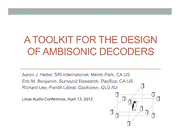
LAC 2012 - Slides: A Toolkit for the Design of Ambisonic Decoders PDF
Preview LAC 2012 - Slides: A Toolkit for the Design of Ambisonic Decoders
A TOOLKIT FOR THE DESIGN OF AMBISONIC DECODERS Aaron J. Heller, SRI International, Menlo Park, CA US Eric M. Benjamin, Surround Research, Pacifica, CA US Richard Lee, Pandit Litoral, Cooktown, QLD AU Linux Audio Conference, April 13, 2012 What is Ambisonics • Extensible, hierarchical system for representing sound fields • Says how something should sound, rather than specific speaker signals. • Capture or creation • Microphone arrays • 2-D or 3-D • Natural B-format, Tetrahedral, Spherical arrays • Ambisonic Panners • Reproduction • 2-D, “horizontal” or 3-D “with height” loudspeaker arrays • “Any” size or shape array of loudspeakers Extensible? • Ambisonics was originally implemented as first order, although always conceived as a hierarchical system • More recently, various system have worked with as high as 5th order. • CCRMA Listening Room works with signals up to 3rd order 2-channel stereo L chan R chan Pressure = L + R Velocity = L + R Sum Human Auditory Localization • At low frequencies (up to about 800 Hz) works by Interaural Time Differences (ITDs) • At middle frequencies (800 Hz to 5 kHz) works by Interaural Level Differences (ILDs) • Transition is fairly sharp • due to the ITDs becoming ambiguous once the wavelength become smaller than ear spacing. • 2-channel stereo doesn’t get it right • ILD cues are such that the images tend to stick to nearest speaker • Ambisonics was designed from the beginning to get this correct with modest resources. • Small number of program channels and loudspeakers Gerzon’s Theory of Auditory Localization • Early workers in stereo did theoretical analysis showing how stereo did (or didn’t) provide proper localization cues • Gerzon’s contribution was to integrate those theories and came up with a theory that defined • r , the vector sum of the signals from the loudspeakers V • r , the vector sum of the squares of the signals from the E loudspeakers. • By providing a simple mathematical encapsulation, we can use these to • design decoders • prove theorems, e.g., polygonal decoder theorem • help understand what various spatial sound reproduction systems can and cannot do Localization Vector Theory • r predicts low-frequency localization almost perfectly. V • If r =1, then low-frequency sounds will be precisely located. V • r predicts mid-frequency localization moderately well. E • If r =1, then mid-frequency localization will be good E • BUT… r is always less than1, unless the sound is coming from a E single point source. • At best r = cos(θ/2), where θ is the angle between the E loudspeakers, so for a square array r ≤ 0.707. E • In general, r is low in directions with few loudspeakers E • Best we can do is have it change smoothly in performance from dense areas to sparse areas. Energy Localization Vector • Maximizing r and getting it to point in the right direction is E the crux of the decoder design problem. • Easy with regular arrays • Irregular arrays always involve tradeoffs • Virtually all real world arrays are irregular! • Arrays need to fit in real rooms • ITU 5.1 is the dominant domestic standard, rear speakers 120° apart. • Because it is a non-linear function of speaker position, we currently need to use numerical optimization methods. What is a Decoder • In Ambisonics, the program format is independent of the reproduction layout. • The decoder’s task is to create the best perceptual impression possible that the sound field is being reproduced accurately, given the resources available • Bandwidth, number of speakers, configuration of speakers … • We use the term “decoder” to mean the configuration for a decoding engine that does the actual signal processing • E.g., Ambdec Goals for decoder design • Mimic conditions of natural hearing • Constant amplitude gain for all source directions • Constant energy gain for all source directions • At low frequencies, correct reproduced wavefront direction and velocity • At high frequencies, maximum concentration of energy in the source direction • Matching high- and low-frequency perceived directions
